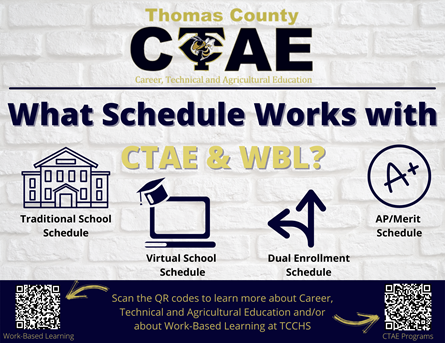 The mission of the Work-Based Learning Program is to assist in providing a highly trained, technologically sophisticated, and career-oriented young workforce. This is accomplished by developing partnerships between businesses, industry, students, parents, school systems, coordinators, and post-secondary institutions which will lead the participating student into meaningful careers.
The mission of the Work-Based Learning Program is to assist in providing a highly trained, technologically sophisticated, and career-oriented young workforce. This is accomplished by developing partnerships between businesses, industry, students, parents, school systems, coordinators, and post-secondary institutions which will lead the participating student into meaningful careers.
To assist in the creation of a strong support structure and partnerships between local employers, secondary schools, technical schools, colleges, and certified training programs.
To provide assistance in the articulation of programs of study between high schools and post-secondary institutions.
To create a system that is industry driven where employers and their representatives help set occupational skills standards, collaborate on curriculum, provide work experience and workplace mentors for students, and certify mastery of skills leading to the award of a skill certificate.
To focus on students' learning about “many aspects” of a broad industry cluster rather than mastering a narrow set of occupational skills.
What is Work-Based Learning?
Work-Based Learning is learning that results from work experience designed to increase the knowledge and skills of the learner. The work experience is supplemented with instruction and activities that apply, reinforce, refine, or extend the learning that occurs during work, so that learners develop attitudes, knowledge, skills, and habits that might not develop solely from work experiences. Students continue to take coursework related to his/her career interest but are also being paid, on-the-job training or a non-paid internship through a structured workplace learning program. It consists of three parts: (1) classroom instruction, (2) on-the-job training, and (3) leadership training.
CLASSROOM INSTRUCTION: Students attend regular classes in the morning, including one related instruction period in the student’s field of study, and are placed in selected work sites in the community for on-the-job training during the afternoon hours. The teacher-coordinator correlates classroom instruction with on-the-job training by visiting students and planning work experiences cooperatively with the student’s employer. Students will receive the appropriate amount of Carnegie units for a minimum of 15 hours per week of on-the-job training. Eight (8) of these hours must be Monday-Thursday.
ON-THE-JOB TRAINING: After securing employment, the student will follow a planned training program under the supervision of the employer and the coordinator and will receive a grade for the classroom instruction and a grade for the on-the-job training every eight weeks. In addition, the student will receive an hourly rate of pay compared to other employees of similar experience.
LEADERSHIP TRAINING: Students are encouraged to be in CTSOs that relate to the field they wish to pursue. Many take on leadership roles within these clubs.
REQUIREMENTS: To qualify for a WBL placement at Thomas County Central High School, a student must be at least 16 years old, a junior or senior, and have good attendance, discipline, and recommendation. Students must also have a defined Career Pathway in order to participate in the Work-Based component of Career-Related Education. This is especially important for cooperative education students in that their job placement is directly related to the curriculum of the CTAE class in which they are concurrently enrolled.